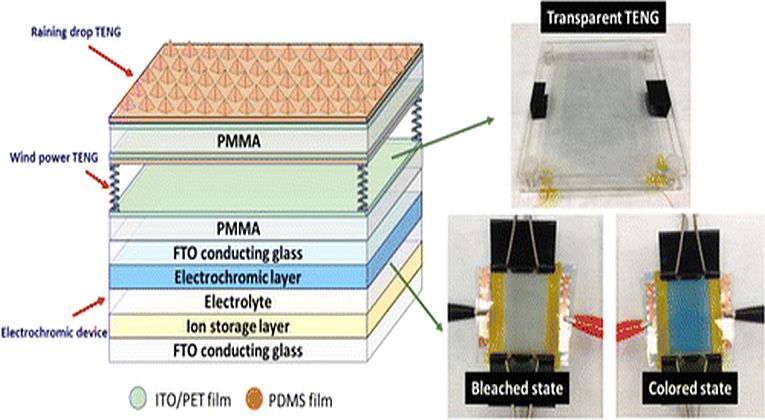This structure was used for a dual mode TENG, with tremendously complex layers of energy harvesters and provisionally-transparent layers of many other components; Credit: © American Chemical Society
The future of glass seems never to be in doubt. But will glass remain as we know it? Already, developments have produced smart glass
of many different types meant to respond to light and absorb light energy. The only common currency of these glasses seems to be a switchability, responding to a change in light or heat or electricity. Now, another means of energy production joins the well-trodden path of photovoltaics research.
An electrochromic layer is common to previous forms of smart glass, but in this technology, an electrolyte and an ion storage layer accompany 2 surface layers that use mechanical energy from wind and elcctrostatic induction from raindrops (which are positively-charged). These transparent layers comprise what has been called a TENG (triboelectric nanogenerator) device. The potential to have a self-powered system is welcomed by those who want to isolate the glass from external electrical sources but still power portable electronics.
A sustainable output and variable optical properties brings this technology a use in charging the like of smartphones at the moment. However, I’m sure Min-Hsin Yeh, Long Lin, Po-Kang Yang and Zhong Lin Wang of The Chinese Academy of Sciences and Georgia Institute of Technology, US have other concepts in mind. The publish a paper on their systems in ACS NANO.Sensing and communication would be ideal functions for such an independent, wireless system harvesting its own energy from the environment. Electrochemical reactions could also be performed, while building security seems one of the simplest steps for such an advanced step into the future of architecture.
Outside of glass for cars or buildings, wearable TENG technology could soon be flexible enough to integrate into our personal electronics. With an electrochromic device (ECD) allied to a dual-mode TENG, smart window systems would need no external power. With solar cells (PV cells), power could be supplied only for part of the day, while the bulk of this equipment could compromise its utility. Without photovoltaic interference with the transparency of the TENG, power could be clearly available for several small devices. The PV on your roof is always in our minds, as we try and cover all the latest developments.
Prussian blue nanoparticles provide a colourful electrochromic layer and zinc hexacyanoferrate (ZnHCF) nanocubes form the ion storage layer. The important part - the power output, consisted of an optimised 130mW/m2 with wind speeds at up to 16.1m/s. Wind impact was harvested very successfully by the allied ECD and TENG in an acrylic substrate. When 2 TENGS (both raindrop-powered and wind-powered) were used high transparency was essential to their functioning, with 60% transmittance over most wavelengths. Wind-powered TENGS were therefore employed in long-term stability experiments. After 100.000 cycles of continuous impact, output dropped very slightly, indicating a good lifetime in prospect. The addition of the 2nd, raindrop-powered TENG would simply enhance the performance.
Smart window systems therefore seem to be part of our future, if only as invisible transparent functionaries in our surroundings. When PV cells are underperforming, or at night, these renewable energy technologies could also lead to back-up systems to maintain our smaller devices, with output current of 45 μA. (that is a power density of 130mW/m2










